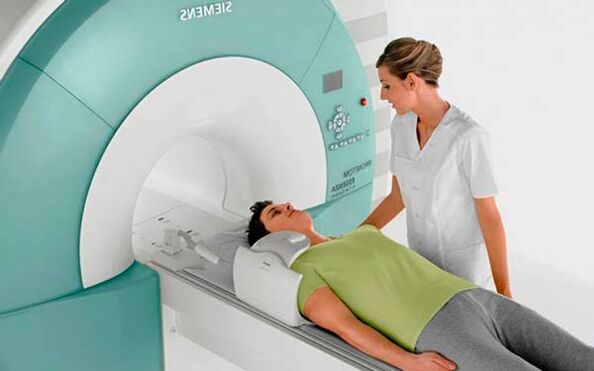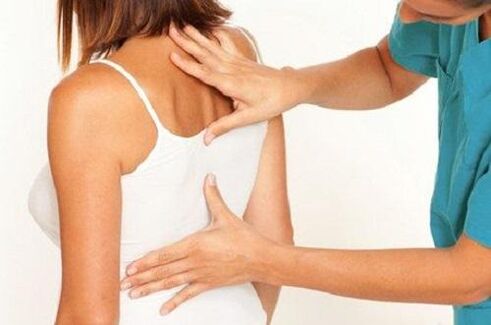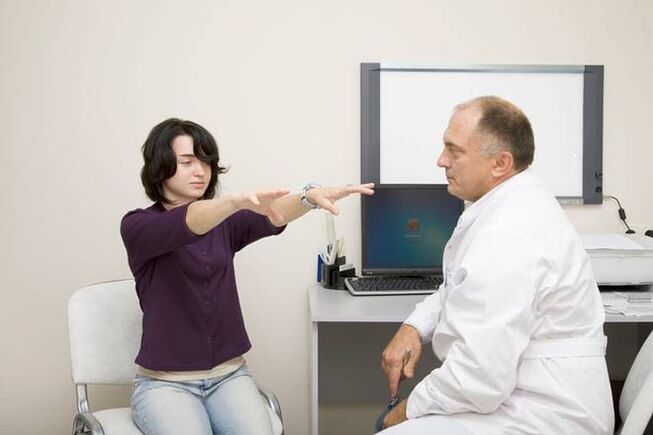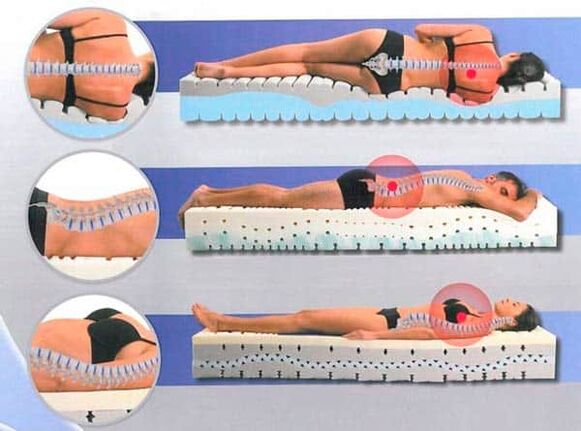Due to relative inactivity and anatomical features, osteochondrosis rarely affects the thoracic region, but this disease cannot be described as rare. Therefore, if you feel stiffness and pain in the shoulder area, you may want to find out what is osteochondrosis of the thoracic spine, what are its symptoms and treatments.
In fact, the disease is rarely localized in this part of the spine, but it has unpleasant consequences and feelings, no less than damage to the neck and lower back. Its peculiarity can be safely called the "fog" of symptoms, in which even an experienced physician may be confused at the onset of the disease.
What is chest osteochondrosis?
Osteochondrosis - degenerative-dystrophic lesions of the discs between the vertebrae and the vertebrae themselves.
As already mentioned, the disease occurs much less frequently in the chest region than in the lumbar or cervical part due to such features:
- the chest region is inactive;
- the ribs and the whole chest are well secured;
- due to kyphosis of the thoracic region (i. e. , physiological flexion of the back of the spine), the vertebrae experience maximum stress in the anterior, more durable part.
But unfortunately, everyone can develop the disease, especially if there are prerequisites for it.
What does an MRI of the chest spine show?
The diagnosis of disease in the chest region needs to be made in a comprehensive way, and MRI shows the true picture better than most studies.
How is an MRI done?
Everything is simple and painless - you have to lie down on a bench that goes into a special spherical chamber and wait for the specified time until the device "illuminates" the body. It is a good idea to remove all metal objects in advance and warn staff if there are pacemakers, prostheses and other foreign objects in your body.
In general, osteochondrosis has previously been diagnosed solely by touch - the vertebrae have been examined, there is pain, which means that osteochondrosis is present. Now doctors supplement their knowledge with special studies, the most informative of which is MRI, which makes it possible to determine the degenerative phenomena in the cartilage and vertebrae, the presence of the hernia and the peculiarities of their development.
If you’re not afraid of enclosed spaces, you can even take a nap.

Symptoms of osteochondrosis of the thoracic spine
The symptoms of insidious osteochondrosis in the chest region are able to hide successfully for a long time without manifesting and do not cause pain or even discomfort. And later, when the damage is already causing obvious manifestations, it is sometimes difficult to determine the source of the painful feelings - they can be given to the heart, internal organs, legs. Therefore, this issue needs to be analyzed in detail.
So doctors differentiate between several symptoms.
The reflex is directly related to the negative effects of the disease on various receptors.
As a result, the patient feels:
- pain in or just below the shoulder blades, often surrounded and squeezed "like a hoop";
- the focus of the pain can be localized on different parts of the body - in the sternum, simulating heart attacks, on the right side, disguised as liver, and even in the lower back like renal colic, so a comprehensive examination of the internal organs is often needed to make a diagnosisfind that there is a problem in the back.
Compression symptoms occur due to compression or stretching of the nerve roots,
as a result, they may be:
- weakness in the legs, seems to be denied;
- loss of sensitivity in the limbs;
- numbness in the pinched area, feeling of "goose hills";
- coma feeling in the chest;
- the tension in the surrounding muscles that can be found during the massage;
- deterioration of the work of the organs, fortunately such neglected cases are rare.
Due to the peculiarities of women's physiology, the symptoms of osteochondrosis of the thoracic region are sometimes confused with other diseases.
Often there is pain radiating to the mammary glands, which automatically makes a woman think about her breast problems.
Drawing, regular pain is similar to fibrosis, tumors and other glandular problems, which is why you need to consult a mammologist. And if the doctor does not find a disorder in the structure and function of the mammary glands after examinations, examination and mammography, we can safely assume the presence of osteochondrosis.
Causes of osteochondrosis of the thoracic region
The causes of osteochondrosis in the chest and other regions are the same, but clear preconditions are needed to locate the problem exactly here:
- curvature of the spine, especially the chest region;
- the presence of bad habits;
- wearing high heels;
- being in an unnatural position for a long time, such as at a computer, sewing machine, weeding a garden;
- tremendous physical activity;
- hereditary predisposition to back disease;
- pregnancy causing a shift in center of gravity;
- refusal to wear flat feet and special orthopedic insoles;
- spinal cord injury.

Signs of osteochondrosis of the chest region
Signs of osteochondrosis of the chest region include pain, stiffness, muscle tension in this area. As already stated, a distinction is made between reflex and compression syndromes, the former being discussed in more detail.
Dorsago and dorsalgia
The most obvious reflex syndromes of the disease are dorsago and dorsalgia. What is that?
Dorsago - cut, severe, sharp pain in the spine, as if someone had stabbed his back with a knife. Sometimes painful feelings spread to the heart or sternum.
The feelings are so "rainbow" that the patient is afraid to perform any movement and even takes a deep breath. When you feel it, you may notice muscle tension near the spine. The most common attack occurs when you sit in an awkward position for a long time and change sharply. Because of the severity of the pain and its localization in the chest, the dorsago is often mistaken for a heart attack, but the removed cardiogram makes the picture clear.
Dorsalgia is a painful pain that gradually manifests itself, extending to the back of the chest, to the chest, increasing with movement, especially tilting and turning the body, even from sneezing or riding over the bumps.
Uncomfortably, it is sometimes difficult to identify the most painful area - these are superficial or deep tissues, back or chest, which makes it difficult to make a correct diagnosis.

What is called intercostal neuralgia?
Sometimes pain is observed in the intercostal spaces and then the symptom is called intercostal neuralgia, this symptom is characterized by:
- severe pain that covers the space between the ribs, sometimes radiating to the lower back, arm, or shoulder blade, and lasts for hours and even days;
- pain when feeling the ribs;
- redness or pallor in the focus of inflammation, burning sensation or, conversely, numbness;
- inability to breathe evenly and deeply - every breath causes agony;
- some muscles in the chest or back twitch spontaneously.
How to treat intercostal neuralgia at home
You need to make a correct diagnosis before treating intercostal neuralgia, as your symptoms are similar to heart disease, and if you start fighting the disease at home with a real heart muscle problem, you can get huge problems.
If this is not your first attack and your doctor confirms your diagnosis, you can use home treatment methods, the most important of which are:
- bed rest for 2-3 days;
- taking sedatives to relieve pain and cramps;
- use of topical analgesics in gels and ointments;
- use of heating agents - mustard plasters and pepper plasters;
- repair of nerve tissue by intake of B vitamins;
- fixation of the spine, for this purpose a corset is used which keeps the body in the correct position and reduces the compression of the vertebrae.
The back pain can actually be removed in a few days, but to avoid relapses, you have to fight the cause for months.
Atypical signs of osteochondrosis of the breast
In addition to clinical manifestations, thoracic osteochondrosis can have completely atypical symptoms that are so easy to confuse with other diseases. Among them:
- in women, imitation of heart or chest pain, discomfort may last for weeks, but further studies do not reveal heart and chest problems;
- localization of pain in the hip region, such as gastritis or colitis, or on the right side, as in liver dysfunction, diagnosis is complicated by impaired digestion along nerves due to impaired impulse conduction, and here it is difficult to prioritize;
- urinary incontinence and loss of erectile function, also due to impaired conduction of nerve endings.
But there is a small clue - the aggravation manifests itself closer to the night, increases hourly after waking up due to tightening of the nerves in the back, and disappears after rest, while the work of the heart or other internal organs is disturbed day and night.
How to treat osteochondrosis of the thoracic spine?
The treatment of osteochondrosis of the thoracic spine is a long issue, moreover, it is impossible to restore the tissues, only the process can be slowed down, its aggravation prevented. But that doesn’t mean you can calm down, reconcile, and do nothing, recognizing the futility of the effort, because treatment gives you the opportunity to live and work fully, and while neglected forms will not end fatally, they will greatly ruin your life.
Drug treatment
For the first symptoms of osteochondrosis, medication involves the use of pain-relieving drugs, for which purpose it is best to take non-steroidal anti-inflammatory drugs.
They are prescribed for 1-2 weeks, during which time the pain usually goes away.
You can combine taking tablets, capsules or suppositories with topical painkillers or compresses (although these can cause allergies, so you should instill them on a small area of skin and wait half an hour before use), similar ointments are also suitable.
Sometimes, for pains of a particular severity, the anti-inflammatory drugs are helpless and then the painkillers in the form of drops are rescued.
In some cases, you will need to inject painkillers along the spine, the procedure is called paravertebral blockage and is performed by a hospital doctor.
Later, muscle relaxants are used to relax the muscles, diuretics are prescribed against the edema around the nerve endings, blood circulation and tissue regeneration restores the trophies. In the future, chondroprotectors should be drunk for several months to prevent relapses.

Home treatment
At home, you can use a number of non-drug methods to treat osteochondrosis, including:
- massage;
- Physiotherapy;
- stretching exercises;
- compressions and infusions to normalize metabolism in the vertebrae.
As for the last point, here you can give advice on such folk remedies:
- rub with marigold tincture, take 200 grams of vodka, triple alcohol and camphor alcohol per 100 grams of flowers, stick for 14 days and rub the affected area before going to bed, wrap in a warm scarf;
- mix the same amount of cellulite and lemongrass herb and pour a glass of boiling water, leave for an hour, strain, add 1 tsp. valerian and honey tincture, drink a glass twice a day for a month.
Exercises for the chest region
Perhaps the practice of osteochondrosis of the thoracic region is most effective in preventing later complications.
Exercise relieves stiffness, relaxes muscles, strengthens them and increases a person’s physical activity. Constant and regular exercise speeds up blood circulation, removes inflammation of the nerve roots, reduces the load on the spine, and this exercise therapy is suitable not only for damage to the chest region, but also for any part of the spine.
But doctors do not recommend such a series of exercises for severe exacerbations, general poor health, coordination problems, high blood pressure, and arrhythmias.
It is better to take a shower, massage and warm up the muscles before training.
So best practices:
- Raise your shoulders 10 times;
- turn your head to the side, frozen for a few seconds at the extreme points;
- put your hand on your back under your shoulder blades, bend and freeze for 10 seconds;
- bend to the side while standing, touching your knees with your shoulders, repeat in the other direction;
- lying on the floor we put a cylinder under our chest, put our hands behind our heads and lift our shoulders and then move the roller a little higher, this movement is used to stretch this section of the spine;
- lying on your stomach, lift your chest above the floor, first with the arms outstretched forward, then with the arms outstretched to the side, and finally with the ones connected at the back in a lock.
Such a charge will help you forget about back problems for many months.
Massage
For osteochondrosis of the chest region, massage helps relieve pain, improve blood circulation and lymph outflow, relieve muscle cramps, improve tone, and enhance trophism in the intervertebral cartilage.
As a general rule, the course does not start immediately on the first day, but after 3-4 days, when the main discomforts have already disappeared, rarely can a masseuse help during the exacerbation period.
The first sessions should be done gently without overburdening the tissues; both skillful hands and special massage machines are suitable as tools. Without proper experience and education, it is not worth having a massage - it can only aggravate the problem, so do not skimp on a specialist course.
Manual therapy
At first glance, hand therapy is similar to massage - the same caress with your hands, but in reality the chiropractor, unlike the massage therapist, does not affect the muscles and skin, but the vertebrae themselves, which requires more strength and skill.
It uses percussion techniques, alternating tension and muscle relaxation, spinal flexion to eliminate abnormalities in the structure of the spine, and instrumental methods used in the treatment of elderly patients.
The manual therapist is able to improve the tone of the back muscles, restore the mobility of the spine, correct curvature and prolapse of the vertebrae, improve blood circulation.
Prevention is the best treatment
You have to make an effort to avoid this unpleasant disease, but it is worth it. Recommended:
- monitors weight as the extra kilogram is an extra burden on the spine;
- eat well and varied;
- avoid spinal hypothermia;
- sports, especially in sedentary work, swimming is perfect;
- take breaks and warm up at work (some of the above complex exercises will take place);
- change poses when you are at the computer for a long time, a desk;
- avoid excessive spinal stress.

Nutrition setup
The condition of the joints, blood vessels, and bones is directly dependent on diet, and if symptoms of osteochondrosis appear, it is worth correcting. So you should exclude:
- smoked meats that clog the body;
- causes the appearance of fried extra pounds;
- sweet;
- soda, especially sweet.
Instead, visit:
- cooked meat and broths of pork, chicken and rabbit;
- vegetables;
- greens;
- dairy products, in particular kefir, cheese and cottage cheese;
- cooked fish at least once a week;
- fruit, apple better.
Proper posture in a dream
Chest osteochondrosis, even in a dream, dictates its own rules and requires you to choose the right postures. You have to give up your favorite rest on your stomach - in this position, your head leans back and your blood vessels are compressed, which impairs blood circulation to the brain.
The best poses for the disease:
- on the side when all organs and limbs are resting and not compressed;
- in the back;
- pulled to the chest with legs bent in the fetal position, the back muscles relax well inside.
I note that no less attention should be paid to the bed, with a solid sole, a hard orthopedic mattress, and a small pillow on which only the shoulderless head is placed, supported at height. We need to say goodbye to our favorite soft mattress and a huge down pillow.

Sitting posture
Even sitting in chronic osteochondrosis should be correct! Tips to follow strictly:
- avoid upholstered furniture;
- choose a chair so that your legs reach the floor and the depth of your thighs is 2/3;
- there should be plenty of space under the table so you don’t have to bend your legs;
- Change your position, warm up, walk with a long sitting every 10-15 minutes;
- make sure your back rests on your back;
- do not lean forward to avoid muscle tension;
- while driving, place a caster under your lower back to maintain a physiological turn;
- even while resting on a couch or bed, change your position every hour, relax your back muscles and stretch.

Osteochondrosis is not fatal, but a very unpleasant disease that needs to be controlled from the first manifestations. Now you know what to look for, how to recognize multiple symptoms, what exercises to do with osteochondrosis, and how to overcome them. Dare and be healthy!



































